|
Aina Mahal, Bhuj.
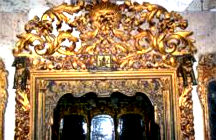
Bhuj has one of the historical monuments named Aina Mahal which is also known as Madansinhji Museum On 1st January, 1977, Maharao Madansinhji, the last ruler of Kutch founded “Maharao of Kutch Aina Mahal Trust”. Madansinhji Museum was made under this trust. This museum has two parts. One part is the Kala Atari Picture Gallery and another part is a marvelous old palace called Aina Mahal.
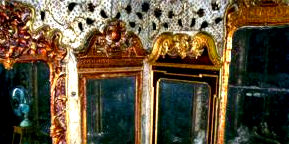
Aina Mahal means a palace of mirrors. It is a creation of 18th century. Ramsinh and Gaidhar Devshi created this amazing palace in the period of Maharao Lakhpatji (1752-1761). Maharao Lakhpatji was very fond of music and culture.
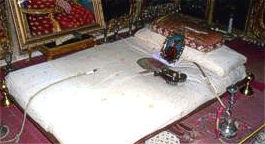
The great master piece of Ramsinh in Aina Mahal is the Hall of Mirrors situated on the second floor. The white marbled walls of Aina Mahal are covered with mirrors separated by gilded ornaments. The Halls of Mirrors is full of a precious collection of objects, a Dutch Clock, English and French globes, many antique pictures, mechanical toys etc. The centre floor of the palace has a pleasure pool lined tiles with a platform above it. Aina Mahal is surrounded by a series of fountains operated by an elaborated system of pumps below a Venation chandelier. Aina Mahal's Art Gallery has many photographs of Bhuj city and the portraits of the rulers.
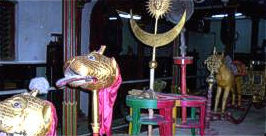
Aina Mahal is open daily (except Saturday) from 9 am to 12 pm and 3 pm to 6 pm. The fee to enter in this Mahal is Rs. 10 each. The pictures, postcards and books are on sale in the palace. Photography and videography are allowed.
Kutch Museum, Bhuj.
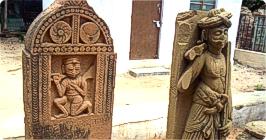
The Kutch museum of Bhuj became a part of the school of Art established by Maharao Khengarji on the 1st July, 1877. This museum is the oldest museum of Gujarat.
In February, 1884, an exhibition of Kutchi Arts and Crafts was held. It included 5897 items. Kutch museum was given some exhibits at the termination of exhibition. These exhibits needed the construction of a new building.
On 14th November, 1884, the foundation stone for the present museum building was produced by the Governor of Bombay, Sir James Fergusson. The two-story building was designed by the state engineer Mc Lelland and it cost about Rs. 32000. The museum remained the preserve of the Maharao who showed it only to his personal guests. The museum was opened to the public only on important religious occasions.
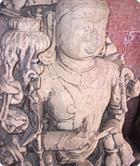
This museum is situated on the banks of the beautiful lake ‘Hamirsar' and in front of the garden ‘Nazar Baugh'.
On the ground floor of the museum, in the centre room, ‘Airavat' is displayed. ‘Airavat' is a carved, wooden, snow white Indian elephant with seven tusks. ‘Airavat' was prepared in Mandvi in the 18th century in the worship of Tirthankar. The rest of its body is painted with flowers. The Indian Government issued a postal stamp showing ‘Airavat' for the memory of this amazing ‘Airavat'.
Kutch museum has a large number of varieties of Kshatrap inscriptions. The oldest Kshatrap inscription found in Andhau and the only Gujarati Abhir inscription of the 3rd century are the main attractions. This museum has almost 11 sections. The archeological section has Indus seals. Different kinds of stone tablets are available also. The painting showing the different vocations of Kutch are on the display. There is also an excellent section which covers classical and musical instruments like Nagfani, Morchang etc. put on the display of the museum.
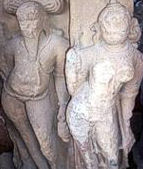
Kutch museum has also a very fine collection of Kutchi silver and golden work, enamellings, textiles, wood work, coins, old utensils, arms and other archeological objects. Here, a section on the communications of the district is also available.
Kutch museum opens daily (except Wednesdays, 2nd & 4th Saturdays of the month and public holidays) from 9 am to 12 pm and 3 pm to 6 pm. The entrance fee of this museum is Rs. 5 each. Photography and videography are allowed. Museum publications are on sale. Researchers can use the reference library.
Bharatiya Sanskriti Foundation, Bhuj

The museum of Bharatiya Sanskriti Darshan was created by a very famous Kutchi scholar of the folk art, Ramsinhji K. Rathod. He was the winner of many state Governments awards. His collection of artifacts and similar objects are excellent. He also founded a trust and a society to run this museum.

This museum has now become the ideal symbolic place for the occasional inquisitive tourists. Almost 1500 rare books on the art and culture of Kutch which are to be ‘Campus for Kutchiyat' are the main collection in the museum. The museum has mainly five sections. An Ethnological section which has Sahitya Chitra is in the central hall. In the museum, we can find the rare books on literature. In other sections, there are interesting artifacts like leather embroidery, wood work, wood carvings, terra cotta, wall paintings, bead-work, stone carvings, musical instruments, knives, swords and silver-work.
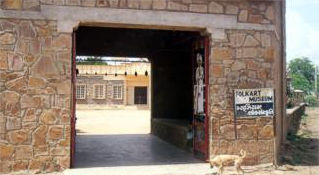
Bharatiya Sanskriti Darshan has countless objects of essential architectural and historical interest on its display. On the outside of the museum, some well-prepared traditional huts are made that show the unsophisticated way of life in Kutch. An intricately designed “Kothala” is inside one of the huts.
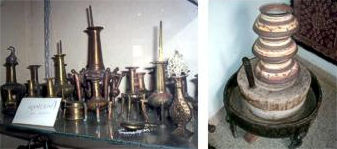
The museum is open daily (except Tuesday) from 9 am to 12 pm and 3 pm to 6 pm. The entrance fee is Rs. 5. Photography and videography are allowed on the payment of fees to enter the museum.
|